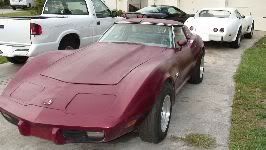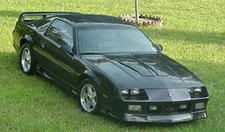

|
| Search | Car Forums | Gallery | Articles | Helper | Air Dried Dog Food | IgorSushko.com | Corporate |
|
| Latest | 0 Rplys |
|
|||||||
 |
 Show Printable Version | Show Printable Version |  Email this Page | Email this Page |  Subscribe to this Thread
Subscribe to this Thread
|
|
|
Thread Tools |
|
|
#1 | |||
|
AF Enthusiast
|
caprice lt1 vs. Camaro lt1
Correct me if I am wrong but the lt1 found in the caprice is exactly the same as the one in the camaro, except for the heads?
So I could get away with using a caprice engine with the aluminum heads from my old camaro engine? I ask because the caprice engine is $900 cheaper than its camaro counterpart.
__________________
 Quote:
Quote:
|
|||
|
|

|
|
|
#2 | ||
|
Confoundingly Lucid
|
Re: caprice lt1 vs. Camaro lt1
Quote:
__________________
1988 9C1 - Modified LM1 @ 275HP/350TQ - TH700R4 - 3.08 8.5" Disc Rear - see it at http://www.silicon212.org/9c1! 2005 Crown Vic P71 - former AZ DPS - 4.6 liters of pure creamy slothness! 1967 El Camino L79/M20 old school asphalt raper Remember - a government that is strong enough to give you everything you need, is also strong enough to take everything you have. |
||
|
|

|
|
|
#3 | |
|
Fight the powwa!!!
 |
Re: caprice lt1 vs. Camaro lt1
The aluminum heads don't heat soak like the iron heads do. The end result will be more power with the aluminum heads but yes, the blocks are identical.
__________________
RIP Hypsi - I just want to express I will never be the same after having lost such a good friend. You meant alot to me and I feel I am a better person for having known you. Til the day we meet again my friend you will always be in my heart. Mods: Weight reduction (I don't wear underwear) |
|
|
|

|
|
|
#4 | |
|
AF Enthusiast
 Join Date: Jul 2005
Location: Orlando, Florida
Posts: 1,364
Thanks: 0
Thanked 0 Times in 0 Posts
|
Re: caprice lt1 vs. Camaro lt1
werent they a lesser displacement though? Like a 5.0 liter or something.
__________________
92 z28 camaro 5.7 TPI current - slp intake runners and base-BBK 52mm throttle body-MSD 8.5mm wires, blaster coil, and 6AL Box-edelbrock headers-160 degree stat.-hotchkis strut tower brace waiting in the garage - LQ4, milled heads 317 casting (10.5 to 1), hardened pushrods, ported LS6 oil pump, manley dual spings with titanium retainers, MTI X1 cam, hawks longtube headers 
|
|
|
|

|
|
|
#5 | ||
|
Fight the powwa!!!
 |
Re: caprice lt1 vs. Camaro lt1
Quote:
__________________
RIP Hypsi - I just want to express I will never be the same after having lost such a good friend. You meant alot to me and I feel I am a better person for having known you. Til the day we meet again my friend you will always be in my heart. Mods: Weight reduction (I don't wear underwear) |
||
|
|

|
|
|
#6 | |||
|
AF Enthusiast
Thread starter
|
Re: caprice lt1 vs. Camaro lt1
yeah I was talking about the 5.7
__________________
 Quote:
Quote:
|
|||
|
|

|
|
|
#7 | |
|
GM S-Series Mod
 Join Date: Aug 2005
Location: Westminster, Maryland
Posts: 2,650
Thanks: 0
Thanked 1 Time in 1 Post
|
Re: caprice lt1 vs. Camaro lt1
the regular caprice got the 4.3 or the 5.0 but the 9C1 and the SS got the LT1.
__________________
2000 Chevy Blazer ZR2 Performance Mods: Numerous Suspension Mods: Some, but not enough Exterior Mods: Just Right 1987 Buick Turbo T Dark Red Low 11 sec sleeper  .030 4.1 block, PT6262E, & other odds and ends.... My Cardomain |
|
|
|

|
|
|
#8 | |
|
AF Enthusiast
 |
Re: caprice lt1 vs. Camaro lt1
so theres absoloutely no difference other than the heads? whats with the llower rpm limit on caprice?
__________________
Car:  1997 M6 SS Camaro [ white ] 285's in the back all else = STOCK. 
|
|
|
|

|
|
|
#9 | ||
|
Fight the powwa!!!
 |
Re: caprice lt1 vs. Camaro lt1
Quote:
__________________
RIP Hypsi - I just want to express I will never be the same after having lost such a good friend. You meant alot to me and I feel I am a better person for having known you. Til the day we meet again my friend you will always be in my heart. Mods: Weight reduction (I don't wear underwear) |
||
|
|

|
|
|
#10 | ||
|
Confoundingly Lucid
|
Re: caprice lt1 vs. Camaro lt1
Quote:
__________________
1988 9C1 - Modified LM1 @ 275HP/350TQ - TH700R4 - 3.08 8.5" Disc Rear - see it at http://www.silicon212.org/9c1! 2005 Crown Vic P71 - former AZ DPS - 4.6 liters of pure creamy slothness! 1967 El Camino L79/M20 old school asphalt raper Remember - a government that is strong enough to give you everything you need, is also strong enough to take everything you have. |
||
|
|

|
|
|
#11 | |
|
Registered Offender
 Join Date: Mar 2006
Location: Rural
Posts: 6,562
Thanks: 8
Thanked 346 Times in 341 Posts
|
Re: caprice lt1 vs. Camaro lt1
In addition to the above mentioned differences, the B-Body LT1s also had a lower lift, shorter duration cam profile.
 They also had a slightly more restrictive intake duct system. PCM programming for the automatic shifting was softer, and the OptiSpark caps in all B-Body LT1s were ventilated in all years, not just '95 and later. PCM fuel cutoff for some B-cars was set a 255 MPH (effectively no cutoff) so the cars would be drag-limited for top speed. The RPM limit on the OBD-I programs I've looked at is above 10,000 RPM =- Again, effectively no cutoff. The real "RPM limiter" was the use of the standard 85# valve springs instead of something more suitable for a good roller cam, and other intake and exhaust restrictions. (Mine turns 6,500 RPM for short bursts regularly - often enough so that I frequently cross the 1,000' traps in second gear at about 92MPH.) I haven't looked that closely at the OBD-II programming for the B-Body LT1s, so that may have changed after 1995. However, the "heat soak" theory is all but invalid with the reverse flow cooling system, and the better flowing iron heads had greater potential for power in all ranges. The cars needed the extra power potential to help offset the ridiculously low K-Factor (stall RPM) of the stock torque converters, 3.08 axles, and more restrictive exhaust. I run my '94 BBBarge at 10.8:1 static (52cc chambers) with 2.02/1.60 valves (something that can't easily be done with aluminum heads), .510/.540 lobe lifts, and can get by on 87 octane if necessary. Head "heat soak" is not a problem. It it is, someone forgot to tell that to my car. Yes, it only run mid- to high 13's, but I can keep a Honda Civic in the trunk as a spare.
__________________
Permanent seat assignment on the Group W bench... Automotive Forums Survival Guide |
|
|
|

|
|
|
#12 | |
|
Fight the powwa!!!
 |
Re: caprice lt1 vs. Camaro lt1
Huh, I never thought about the heat soak effect with the reverse cooling in mind and flow wise in stock form the B-body heads are the superior design but the aluminum heads clean up nicer IMO and I would like to see a dyno comparing the two run by run.
I think the aluminum heads are the better of the two heads once you start getting into modification work, why can't you easily get 2.02 intake and 1.6 exhaust valves?. I know plenty of Vette's and F-body owners running that size valve. I also believe chamber wise you get less compression in stock form with the Iron LT1 version. Although this can be changed like you did.
__________________
RIP Hypsi - I just want to express I will never be the same after having lost such a good friend. You meant alot to me and I feel I am a better person for having known you. Til the day we meet again my friend you will always be in my heart. Mods: Weight reduction (I don't wear underwear) |
|
|
|

|
|
|
#13 | |
|
Registered Offender
 Join Date: Mar 2006
Location: Rural
Posts: 6,562
Thanks: 8
Thanked 346 Times in 341 Posts
|
Re: caprice lt1 vs. Camaro lt1
The aluminum heads have pressed valve seats that sometimes present two problems to machining.
The first problem is the small size and position of the seats. If the seats are not installed in nearly perfect concentricity with the valve port, machining them larger can either break through the seat insert or render it so thin that it becomes a weak point. The head can drop the seat under heat and stress conditions, and that gets very ugly very fast. The seats are made barely large enough to accomodate 2.00/1.55" valves, and while incresing the exhaust valve face size another 0.050" is usually considered minor machining, it can be enough to break through on the small factory inserts. The second problem is seat retention. They are machined for interference and pressed in place. While in operation, the seats normally only see linear forces from the valve landing on it. While in machining, the seats will be subjected to rotational forces. This may be enough to break the seats free and allow them to spin. Once that occurs, the risk of dropping a valve seat insert is very high. If the head is used (not brand new), the thermal cycling it has had during its service life will make the seat even more subject to spinning out, since the expansion rates of the aluminum substrate and steel inserts are different. Many machinists who are aware of this will recommend cutting or pulling the factory seats and installing replacements, then machining for larger valves. This can present its own problems, since core shift in the casting process can make a larger seat almost impossible without breaking through the castings into the cooling jackets. Therefore, while it can be done successfully in many cases, there are risks involved, and in some cases a "simple" valve enlargment can render a casting completely useless. If you ask your machinist about it, don't be surprised if he/she will accept the job but only at YOUR risk, and will not accept responsibility for any damage. If your machinist is not aware of the risks, be wary. Iron heads merely have induction hardened areas around both the valve seats, and therefore can be machined for 2.02/1.60" valves or even 2.05"/1.55" valves (so long as the exhaust valve is kept smaller to accomodate both of them in the chamber). However, given the flow characteristics of these heads, increasing the intake valve without the exhaust valve is almost useless. The restriction is not really on the intake sides. As for the aluminum castings being the "better" heads for modification, that's all relative. I know that many of them have had good work done, and have seen improvements as a result. However, I suspect it is easier to start with an iron head and end up with larger port runners and smoother transitions than with an aluminum head. The valve seat inserts alone make blending the short side radii of the valve bowls a very tricky, risky endeavor, and the result would still be a necessarily larger "hump" of material around the short side to keep the seat insert embedded in aluminum. The iron just doesn't care. I also suspect that removing enough material to yeild 194/80cc finished runner volumes would be dangerously close to hitting water on an aluminum casting. Very easy in iron: 
__________________
Permanent seat assignment on the Group W bench... Automotive Forums Survival Guide |
|
|
|

|
|
 |
POST REPLY TO THIS THREAD |
 |
|
|